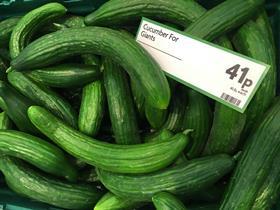
A giant knobbly fruit famed as tasting of frogskin and rotten fish certainly doesn’t sound appealing, but cucumber growers will be hoping the ‘snozzcumber’ will do its bit to reinvigorate the category.
A real-life version of Roald Dahl’s fictional fruit, which hit the shelves last week, is the latest in a line of off-piste cucumber varieties developed to boost sales in recent years. These have included snack sizes, minis and midis, as well as white and yellow cucumbers. But as Lee Stiles of Lea Valley Growers’ Association points out, “it’s a very hard product to innovate”.
Snozzcumbers may prove popular “as a fad”, he says, but not as a staple. Tesco has trialled curly cucumbers in the past, but they are not a long-term proposition for the grower, Stiles believes. “Producers would rather grow the premium straight cucumbers instead, in order to achieve the best price.”
Unfortunately for growers, Class I cucumbers now fetch very low prices, too. Over the past four years, cucumber prices have fallen from 89p to 45p at Sainsbury’s and Morrisons is selling both its regular cucumber and its snozzcumbers for just 41p apiece.
“Cucumber prices are spiralling down,” says Derek Hargreaves from the Cucumber Growers’ Association. “Most of the growers that are left in the business have survived because they are either efficient or they rely on family labour.”
Hargreaves blames the supermarket price war for squeezing producers’ margins, claiming that a reduction in fuel prices is the only thing keeping British growers profitable. “If the fuel price had been where it was three years ago, I don’t think there would be an industry,” he says.
But the underlying reason for price deflation has been what Hargreaves calls the “uncontrolled dumping of product from the Netherlands”. Dutch growers have been selling to UK wholesale markets for 8-10 cents [around 7p] a stick, which is well below the cost of production. “With the best will in the world, you can’t grow them for less than 18-20p in the summer,” he says.
Another issue for growers this season has been a lack of light, which has been at its lowest level for at least 10 years, according to Hargreaves. But this can be contrasted with a reduction in fungal disease mycosphaerella, which attacks the stems, leaves and flowers of the cucumber plant, causing fruit rot.
In lettuce, growing conditions have also been a factor. Vito Mauro, company director at Valefresco, reports that there have been gaps in production due to heavy rain in May and June. The firm experienced a shortage of baby spinach for three to four weeks in July, which forced it to rationalise produce between customers. “We got through it but we had to buy a bit in and take it steady with sales,” says Mauro.
An improvement in the weather has meant there is now plenty of product available and sales at the company have been steady – particularly in baby leaf products spinach and rocket, which continue to see high demand in retail and foodservice.
Overall, this summer has been a positive one for leafy salad sales, according to Chris Hall, managing director at Vitacress Salads. Bagged salad has enjoyed a 6.8 per cent rise in volume sales, while sales of salad bowls have increased by an impressive 22.8 per cent, according to Kantar data for the 52 weeks to 14 August.
“Salad leaves are being seen as more of an ‘ingredient’,” explains Hall, “with spinach, watercress and rocket used more and more in soups and juices, on pizzas and in foods such as pesto.” Consumers are now taking a keener interest in different salad leaves and are actively looking for new leaves when shopping, he reports.
Health also continues to be the key driver in salad sales. “The consumer is being exposed to more salad inspiration than ever, with a huge number of chefs, celebrities and bloggers driving trends around healthy eating such as paleo, low-carb diets, blood sugar diets and clean eating,” says Hall.
In tomatoes, opportunities are growing on the vine, according to Stiles. “There is a lot of consumer demand for vine tomatoes; you can get a reasonable price for them at the moment; and you only get one crop a season, which brings economies of scale,” he explains. Lea Valley growers are in the process of building 50 acres of new glass for vine tomato production – an investment prompted by the understanding that consumers prefer vine tomatoes and smaller sweeter varieties to large round ones.
Overall, the consumer trend to shop little and often has seen shoppers buying tomatoes more frequently, according to Richard Diplock of Thanet Earth and the Tomato Growers’ Association. Wellpak’s Rebecca Quinney also reports an increase in public consumption brought on by the recent heatwave. “When the sun shines and temperatures rise, it inevitably leads to an increase in salad consumption,” she says.



